Thunderbolt on Windows Part 2: Intel's DZ77RE-K75 & ASUS' P8Z77-V Premium
by Anand Lal Shimpi on June 3, 2012 2:08 AM EST- Posted in
- Motherboards
- CPUs
- Intel
- Asus
- Thunderbolt
- Ivy Bridge
- Chipsets
Quad-core mobile Sandy Bridge, 2.5" SSDs and Thunderbolt together have allowed me to use a notebook as my primary work machine. I get all of the portability benefits of a notebook, but with almost none of the performance sacrifices. The only thing I'm really missing is a good, external discrete GPU solution but that's a problem being worked on either via Thunderbolt link aggregation or the second revision of the Thunderbolt spec.

Despite what it's done for me, Thunderbolt has to be one of the most strangely handled interface specs of recent history. Intel engineered the spec, but Apple helped with a lot of the connector and cable design and as a result received a year long exclusive on Thunderbolt. Since its introduction, Thunderbolt has received a reasonable amount of support on the Mac platform. Apple even builds a display designed exclusively for use with Thunderbolt equipped Macs. Companies like Promise, Seagate, Western Digital, LaCie and Elgato are all shipping Mac compatible Thunderbolt devices as well.
With the exclusivity agreement over, Intel's partners in the Windows PC space are allowed to ship Thunderbolt enabled motherboards and systems. Making things even more bizarre is the fact that all Thunderbolt devices have to go through Intel's certification program if they are to be approved for use under Windows. Technically only Promise's Pegasus is certified (or about to be certified) for use under Windows, despite the fact that all of these Thunderbolt devices have been available for use under Windows via Boot Camp on Macs.
The complications extend even further when you realize that Apple's own products aren't certified for use under Windows. The Thunderbolt Display is only officially supported under OS X and I don't see Apple being incredibly motivated to work on Windows certification for it. Interfaces like USB are great because you can generally count on anything that physically fits in the port just working. With Thunderbolt on Windows we now have a situation where you can't assume the same.
We got the first look at a Thunderbolt equipped PC motherboard with MSI's Z77A-GD80 a couple of weeks ago. The interface worked but was not without its quirks. To be totally fair however, the Thunderbolt experience under OS X isn't perfectly problem free either. It turns out that MSI sampled that motherboard prior to making it through the motherboard certification process. Since then, the motherboard has made it through cert and has an updated BIOS that should improve its behavior.
Both Intel and ASUS sent us their latest, fully certified, Thunderbolt equipped motherboards for another look at how the interface works under Windows. With motherboards available today, it's now time to take a complete look at what Thunderbolt is like outside of the Apple ecosystem.
The Motherboards
ASUS sent its P8Z77-V Premium motherboard with Thunderbolt support, while Intel sent its DZ77RE-75K Thunderbolt board. Only the ASUS board is publicly available and is priced at $450. ASUS will have a more affordable SKU with integrated Thunderbolt available in the future: the P8Z77-V Pro/Thunderbolt, which should be priced below $300. Other ASUS boards will be upgradeable to support Thunderbolt via an on-board header + add-in card.
The Intel board starts at $262 and goes as high as $278 depending on the in-box configuration (both include WiFi/BT dongles, while the $278 version comes with front panel USB 3.0 support).
Both boards branch the Thunderbolt controller off of the Z77 PCH, borrowing four PCIe 2.0 x1 lanes. Given how full featured these motherboards are, PCIe switches are employed to allow the use of all the remaining PCIe devices connected to the PCH.
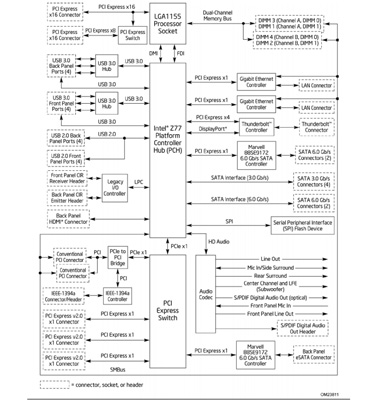
Intel's Z77 Thunderbolt Motherboard Block Diagram
ASUS goes one step further and includes a PCIe 3.0 switch to enable quad-CF/SLI support despite the limited number (16) of PCIe lanes Intel's LGA-1155 CPUs provide. ASUS' board features all the bells and whistles including a 32GB Marvell based Liteon mSATA SSD:
The Thunderbolt port on both boards can serve as either a Thunderbolt port or a DisplayPort output, similar to the behavior on a Thunderbolt Mac. Discrete GPUs are supported through the on-board Thunderbolt/DisplayPort output, provided you have Lucid's Virtu software installed.
As Thunderbolt carries more bandwidth than USB 3.0, trace routing is very important to achieving max performance. You'll notice that on all Thunderbolt boards we've tested thus far, the Cactus Ridge controller and Thunderbolt port are very close to one another. The spec for max trace length between the Thunderbolt controller and port is two inches, compared to up to 10 inches for Intel's USB 3.0 controller.
ASUS tells us that in order to reduce crosstalk it spaced Thunderbolt traces 1.5x wider than traces for USB 3.0 on its boards. Finally, all Thunderbolt traces are on the same PCB layer and don't feature any sharp angles in their route—only gradual arcs, which further improves performance. There's an impressive amount of engineering that has to go into bringing Thunderbolt support to a motherboard.
BIOS/UEFI support for Thunderbolt appears to be identical across all of the third party board makers. ASUS' Thunderbolt options look identical to MSI's for example:
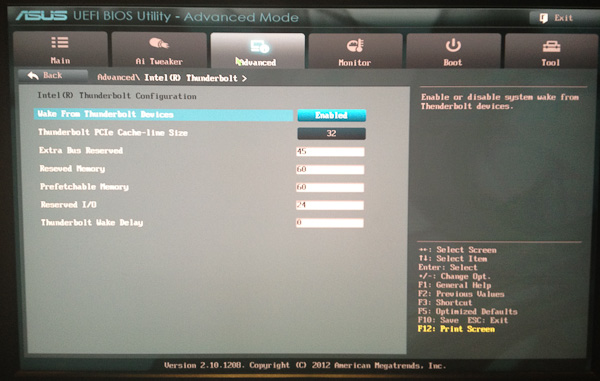
Interestingly enough, Intel doesn't actually expose any of the specific Thunderbolt settings. The Intel board just lets you enable/disable the interface itself:
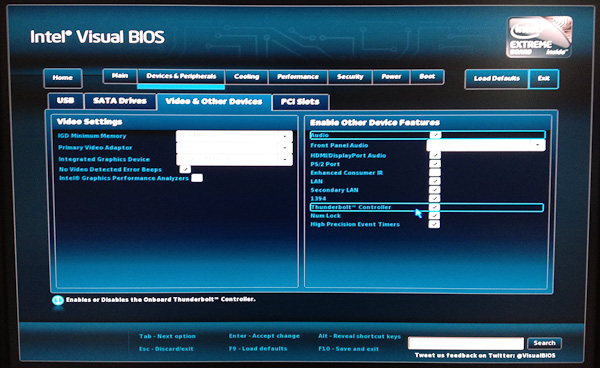


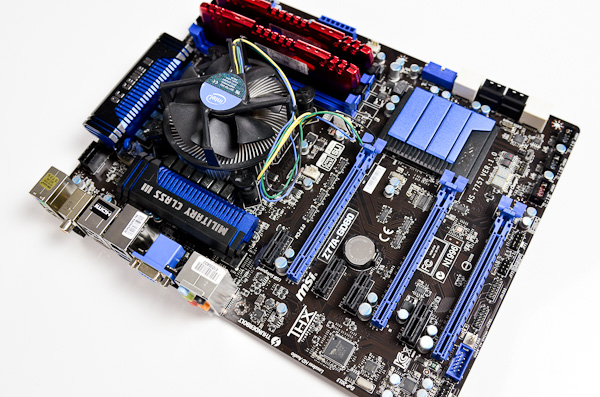
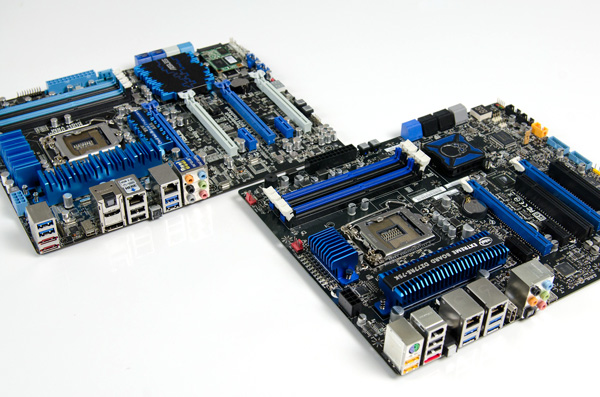

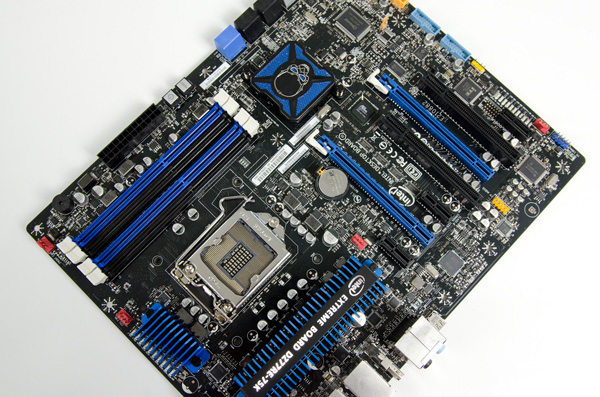
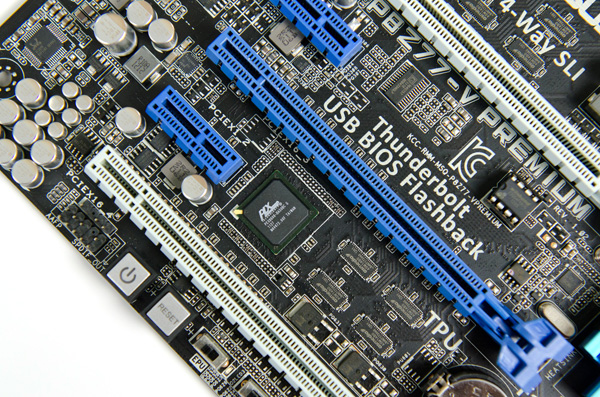
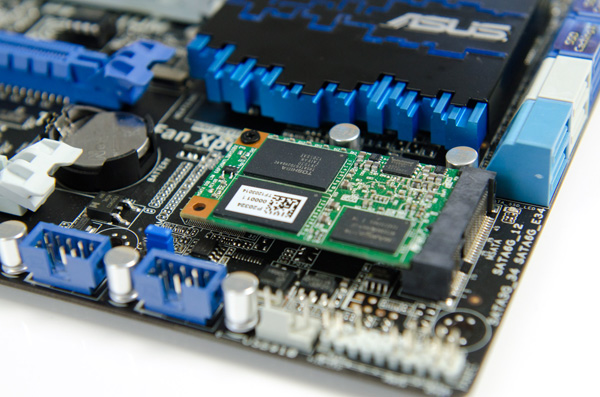
















116 Comments
View All Comments
BigBoss88 - Wednesday, June 6, 2012 - link
I am using a thunderbolt display with my P8Z77 Premium motherboard. Everything works fine without issue, sound, USB hub, firewire. I even have Lucid MVP Virtu running my HD7970 in "headless mode". It runs my games flawlessly. My machine is a beast with a high quality expensive display. Let all the hate posts flood in! C'mon NAAAHHHHHHH! * in my Trey Parker Tinasaurus voice*CeriseCogburn - Friday, July 6, 2012 - link
So yourmum would be proud ? Maybe yourmum is glad the big fat bug got worked out after the who knows how long frustrations...yourmum aka bb88 : " I feel people should know this already BUT just incase, if you do plan on using an Apple thunderbolt or ANY thunderbolt enabled display- Make sure you leave the discrete graphics card OUT of your system until you set the BIOS/UEFI for the computer to have integrated graphics ENABLED before you install your beefy GPU for Virtu support. Do not set it to AUTO either. And on that note I will end my review. "
Gee, sorry to hear the setup was such a hassle. Was that hateful enough ? Do you feel better now that you got some attention ?
twotwotwo - Wednesday, June 20, 2012 - link
You have to wonder if Apple shot themselves in the foot with the exclusive deal. Making it widely available would have meant more compatible devices "for free," and only(?) cost Apple bragging rights for a year. If, instead, it had been available in different speeds and only Apple had the right to deploy the fastest one, or something like that, it could have wound up an advantage for them.But temporary exclusivity on a standard, when you've still got just a fraction of the desktop/laptop market (quite unlike the mobile world), seems like a prize you don't want.
Asterix007 - Tuesday, June 26, 2012 - link
Do you guess a MB with Thunderbolt should work on a Imac27 (avril2011) with Thunderbolt port and TB cable also ?With the CMD+F2, we could commute iMac as a display...
I tried with the Z77A-GD80 but no success for the moment...
Thx for help !
CeriseCogburn - Friday, July 6, 2012 - link
I wonder how long it took for the "engineers" to figure that out... or..." We've been doing it this way for 5 decades, now you want to change things?!"
http://www.anandtech.com/Gallery/Album/2007#4
Slalom and curve instead of highest g near right angle turns - with 3%+ to 7%+ improvements.
We are progressing... slowly, very slowly, as so many facts are ignored too often.
nanofunk - Tuesday, July 10, 2012 - link
i am wondering if linux support for thunderbolt will ever be ready. there are currently a lot of troubles with the implementation, when you check the linux kernel mailinglist. if there is not at least (hotplugged) networking up and running, i don't see why we should invest in thunderbolt at all.